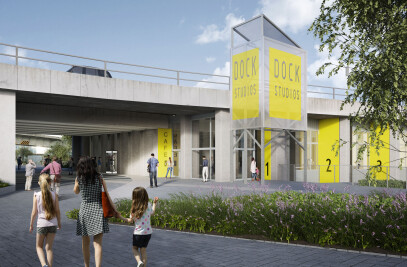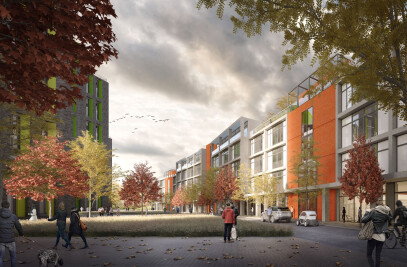The walls of these British beach huts are formed from recycled timber pallets, bolted into a frame and lined internally with ply and externally with triple wall polycarbonate sheeting. The wall cavities will then be filled with pebbles, crushed glass, shells etc. laid in strata to create an individual pattern for each hut as well as providing thermal mass, privacy and security. Above eaves level a clear polycarbonate lining allows afternoon sunlight into the huts.
More from the Designers:
“A beach hut is a uniquely British experience and one of the simple pleasures of a seaside holiday at home…the perfect place to change out of damp swimming costumes, make crab sandwiches, shelter from the weather and watch the world go by” The site at Shoeburyness is an untamed stretch of coastline just around the corner from Southend. It is characterised by big skies and timber groynes with distant views of a cold war barrier, huge ships, and power plants. The beach grades from pebbles, shells and broken bricks down to estuarial mud. Beach Huts were positioned on the site until the 1980s and continue to line much of the Southend sea front. We took the defining characteristics of beach huts to be a strong rhythm and profile, a sense of variety and individuality within the overall pattern, a robust and simple form, and the creation of an intimate space within a big landscape.
Our proposal creates distinctive beach huts with an undulating roof profile that can be seen from the promenade behind and above the site. Gaps between the huts allow views out to the sea and the planted roofs reflect the existing green margins between the beach and the land. The huts are oriented to the south with an assymetrical plan which gives plenty of sitting space at the front overlooking the view and a narrower working and storage space to the rear. The orientation and form of the huts means that each hut has a private external space in front of it, open to the beach and the view but not overlooked by the huts to either side. The beach hut walls are formed from recycled timber pallets, bolted into a frame and lined internally with ply and externally with triple wall polycarbonate sheeting. The wall cavities will then be filled with pebbles, crushed glass, shells etc. laid in strata to create an individual pattern for each hut as well as providing thermal mass, privacy and security. Above eaves level a clear polycarbonate lining allows afternoon sunlight into the huts. The roofs, seen from above, are simple canted timber trays, filled with sea hardened sedum which is now being colonised by local plants. The sea elevation consists of full height plywood panels painted in a range of colours, one half divided into stable doors and one half fixed. The doors can be half or fully opened as suits the weather and the occupants, while the fixed panels create screened changing space inside the huts and are painted with industrial scaled hut numbers on the outside. The robust internal ply linings make it easy for each hut owner to customise their own space.

































